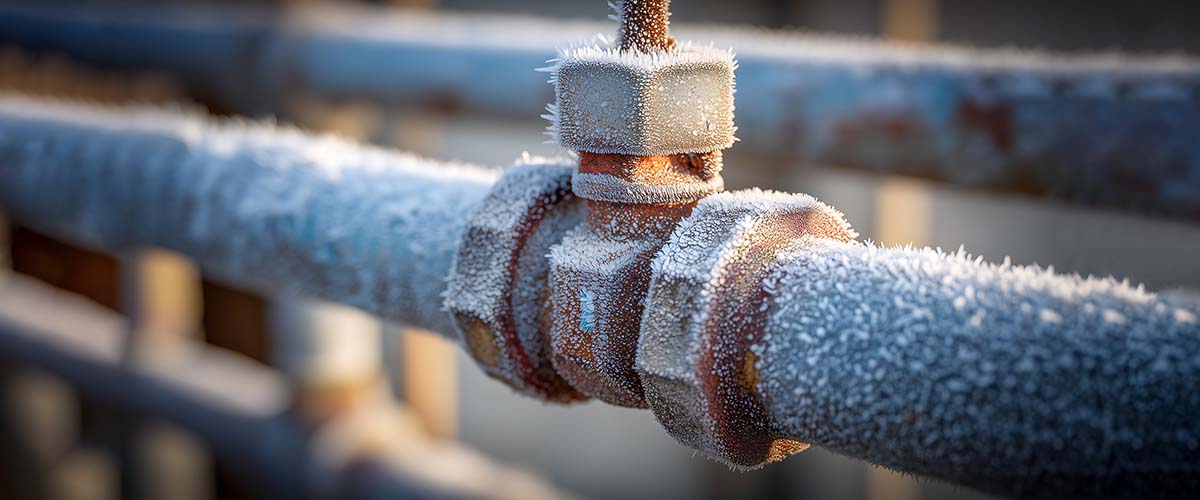The kitchen tap just hisses—frozen pipes. The base of the cabinet feels like a freezer. Take a breath. I’ve thawed more lines than I can count, and I’ll walk you through what to do right now to get water flowing again—and how to keep it from happening in the future. Winston-Salem gets those sneaky blue-sky freezes that bite at dawn, so here’s how to handle frozen pipes today and prevent another morning surprise.
Safe Ways to Thaw Your Frozen Pipes
Thaw frozen pipes gently. Open the nearest faucet—both hot and cold—so pressure has somewhere to go if ice breaks loose. Grab these safe helpers:
- Hair dryer on low to medium. Keep it moving.
- Space heater at least three feet away, pointed under the sink or toward the wall cavity.
- Warm towels, refreshed every few minutes.
- A “rice sock”: A clean sock full of dry rice, microwaved warm, draped over the line.
Do not use a blowtorch. Don’t use an open flame. And no salt-in-pipes tricks—makes a mess. If you can reach the shutoff for that fixture, turn it halfway off to calm things down while you work. Open your cabinet doors. Let the room heat in. If you hear that hollow thunk when you tap the pipe, it’s iced; work from the faucet back toward the cold spot. I’ve even thawed frozen pipes with nothing more than a hair dryer.
How to Fix Frozen Pipes
Step-by-step is your friend:
- Find the coldest section—frosted, sweating, or just colder to the touch.
- Open the faucet. Even a drip helps.
- Aim gentle heat to thaw frozen pipes. Hair dryer first. Heat tape if you already have it installed.
- Thaw from the faucet end toward the ice, inch by inch, so melting water can escape.
Most houses run at about 50 PSI; anything above 80 can cause trouble. That’s why opening the tap matters. Watch for leaks while warming; a split will show up as a bead, then a weep. Found a split copper elbow after the “hollow thunk” test; water sprayed the pantry like New Year’s confetti. If you spot a crack, kill the main shutoff and drain what you can by opening every tap. Compression fittings don’t need Teflon tape; the ferrule makes the seal. No torch. No kerosene heater in a crawlspace. If the ice is behind a wall, keep the heat indirect and steady; patience beats drywall dust.
Preventing Frozen Pipes
Preventing frozen pipes is cheaper than drywall. Wrap exposed runs with foam insulation. Add UL-listed heat cable on the vulnerable stretch—crawlspace feeds, garage laundries, kitchen sinks on exterior walls. Stuff pipe penetrations with foam or putty to block drafts. Disconnect hoses and use insulated covers on outdoor spigots. Keep the thermostat steady at 55°F or higher when you’re out. On the coldest nights, let a pencil-thin stream run; moving water resists freezing.
Mineral buildup narrows pipes and slows flow—bad combo when it’s 12 degrees. Flush your water heater yearly; sediment piles up fast around here. Clean faucet aerators; I always check the aerator first, even on a freeze call. Got older galvanized lines? Common in West End. For them, even a little ice can stop everything. Consider targeted repipes in those sections. Leak sensors under sinks are cheap insurance; they ping your phone before the ceiling stains. Normal water pressure should be 40–60 PSI, which is worth checking with a $15 gauge so pressure doesn’t hammer a weakened line. Speaking of smells, a damp crawlspace after a thaw can stink like wet dog. Fans on, dehumidifier if you’ve got one.
When Do Frozen Pipes Need Professional Help?
Call a pro when: you can’t find the frozen section, the line vanishes into a wall, or you’ve thawed for 90 minutes with zero progress. Also, call if you see a bulge, hear sizzling when warming (that’s water flashing to steam), or spot any fresh staining on ceilings or baseboards. Main line frozen? That’s not a hair-dryer job. Turn off the main, open low taps, and let us bring the big heaters and thaw rigs.
I once pulled a burst under a West End sink while snow drifted in. The smell lingered like wet dog for days. Here’s what they don’t tell you: the real damage is often the slow leak that starts after the thaw, not the freeze itself. While you wait for help, protect the house—move rugs, pop a hole in a sagging ceiling bubble with a screwdriver into a bucket, and run fans. Insurance often covers sudden bursts; photos help. And if we find a freeze-prone run, we’ll reroute it smarter so next cold snap you sleep, not babysit towels. No romance novels shielding a split line this time—I’ve seen that too. Our experienced plumbing professionals can assess and repair any damage quickly.
Frequently Asked Questions About Frozen Pipes
How long should thawing take?
Usually 20–90 minutes with steady, gentle heat. If nothing changes, call.
Hot or cold faucet drip?
Cold matters most, but a tiny hot helps recirculate warmth near the mixer.
Can I use a space heater safely?
Yes—three feet clearance, no fabric nearby, never unattended.
Frozen pipes but didn’t burst—am I fine?
Maybe. Keep an eye out for weeping joints over the next day.
Should I pour salt or antifreeze in the drains?
No. Antifreeze is toxic; salt doesn’t fix a frozen supply line.
Do I need to replace all my pipes?
Not if it’s a one-off. Repeat freezes or old galvanized? Targeted upgrades save headaches.

